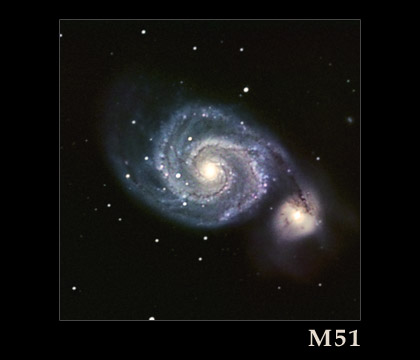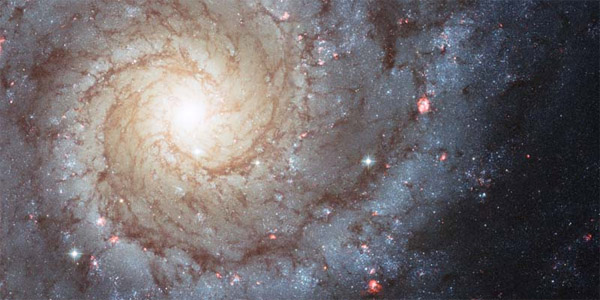Looking at the sky through a telescope is a lot like reading—you need to use your imagination to complete the picture. That bright pale orb? That’s the planet Jupiter, large enough to swallow a dozen Earths and home to the largest hurricane in the solar system. That ghostly smoke ring? That’s a star exploding—a cataclysm that must have destroyed its planets and that awaits us in less than a billion years. And that fuzzy patch of oval light? Yes, that patch of light is a galaxy!
Nothing in the sky stretches our mind quite like a galaxy. A hundred-thousand light-years across, yet so far away that all we see is a smudge. Its billions of stars spin silently away, out of sight and out of mind to approximately 100% of the world’s population. Seeing a galaxy is the closest we will ever get to grasping the vastness of the universe.
So how can I see a galaxy?
Specs & Credit Cards
Whether you’re peeling potatoes or diving to the bottom of the ocean, you’re going to need specialized equipment. Seeing a galaxy is no different. You can see the Andromeda Galaxy (M31) with the naked eye, but seeing it through a telescope can be a lot easier and potentially more satisfying. So what kind of telescope should you get?
Like cars and women’s shoes, telescopes come in a range of prices and specifications. Unfortunately, some of the specs retailers highlight (like magnification power) are not the ones you should pay attention to if you want to look at galaxies.
One thing you should look for, especially as a beginner, is a telescope with a computerized go-to system. We started pointing telescopes at the sky in 1609, but it took 164 years before Charles Messier stumbled on M51, one of the brightest galaxies in the sky. Finding things in the sky is hard! A computerized go-to system will point the telescope at the right spot—as you gain experience, you will learn how to navigate on your own, but there’s nothing wrong with starting easy.
The next thing you should look at is the focal ratio of the telescope. The shorter (faster) the focal ratio, the brighter the galaxy will look. A galaxy through a telescope with an f/6 ratio will appear four times brighter than through an f/12 telescope. As a kid I had an f/4.2 Astroscan that showed beautiful, bright views of nebulae; when I was older, I bought a much larger f/10 telescope and I was surprised at how much dimmer things looked.
Of course, my f/10 telescope made everything look bigger, and that’s the another spec you should look at. The focal length of a telescope determines its base magnification. The longer the focal length, the larger the galaxy will look. The eyepiece you use also determines magnification, but using a standard eyepiece, a longer focal length gives you a larger image.
Sounds easy, right? Just get the telescope with the shortest focal ratio and the longest focal length. The Keck telescopes have a focal ratio of f/1.75 and a focal length of 17,000 mm! I highly recommend them—if you have the means.
Unfortunately, I neglected to mention one detail: Focal ratio and focal length are related. The focal ratio is the ratio of the focal length to the aperture (the diameter of the telescope). That means that increasing the focal length (which is good) also increases the focal ratio (which is bad) unless you also increase the aperture (which is expensive). As always, it’s a trade-off.
Telescopes Compared
Armed with our basic knowledge, let’s compare some telescopes in the market today.
| telescope | f-ratio | focal length | go-to? | price |
|---|
| Astroscan | 4.2 | 445 mm | no | $200 |
| Celestron StarSeeker | 5 | 650 mm | yes | $400 |
| Orion SkyQuest XT8 | 5.9 | 1200 mm | yes | $500 |
| Orion SkyQuest XT10 | 4.7 | 1200 mm | yes | $670 |
| Keck | 1.7 | 17500 mm | yes | $100 million |
Astroscan Telescope
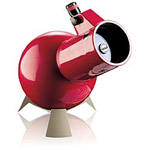 I’m very fond of this telescope because I grew up with it, but it is hard to recommend for galaxies because it doesn’t have a computerized mount. Still, the views through the Astroscan are incredibly bright—it’s like looking out the porthole of your own starship. The view of the Pleiades is particularly magnificent.
I’m very fond of this telescope because I grew up with it, but it is hard to recommend for galaxies because it doesn’t have a computerized mount. Still, the views through the Astroscan are incredibly bright—it’s like looking out the porthole of your own starship. The view of the Pleiades is particularly magnificent.
Celestron StarSeeker 130mm Reflector
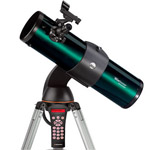
 This go-to reflector is a great beginner scope. It’s small and portable, it has a good focal ratio for galaxies, and it’s very reasonably priced. I think it would be hard to go wrong with this scope. Note that there is also a 100mm refractor version of the StarSeeker. In my opinion, the 130mm reflector is better for galaxies, while the 100mm refractor (f/6) is better for planets.
This go-to reflector is a great beginner scope. It’s small and portable, it has a good focal ratio for galaxies, and it’s very reasonably priced. I think it would be hard to go wrong with this scope. Note that there is also a 100mm refractor version of the StarSeeker. In my opinion, the 130mm reflector is better for galaxies, while the 100mm refractor (f/6) is better for planets.
Orion SkyQuest XT8
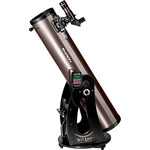
 The Orion SkyQuest has a longer focal length (1200 mm) which means a galaxy will appear larger. But XT8 trades off focal ratio. At f/5.9 it is slower than the StarSeeker, so galaxies will be dimmer.
The Orion SkyQuest has a longer focal length (1200 mm) which means a galaxy will appear larger. But XT8 trades off focal ratio. At f/5.9 it is slower than the StarSeeker, so galaxies will be dimmer.
Orion SkyQuest XT10

 On the other hand, the XT10 has the same focal length as the XT8 but it has a bigger aperture (10” vs. 8”). This means the focal ratio is faster. At f/4.7, it is better than the StarSeeker in all respects. A galaxy will be bright and big. The trade-off, of course, is price!
On the other hand, the XT10 has the same focal length as the XT8 but it has a bigger aperture (10” vs. 8”). This means the focal ratio is faster. At f/4.7, it is better than the StarSeeker in all respects. A galaxy will be bright and big. The trade-off, of course, is price!
Below is a simulated view of M51 through each of the telescopes mentioned above. As you can see, the view through the Astroscan and the StarSeeker is small but bright. The XT has the best view.
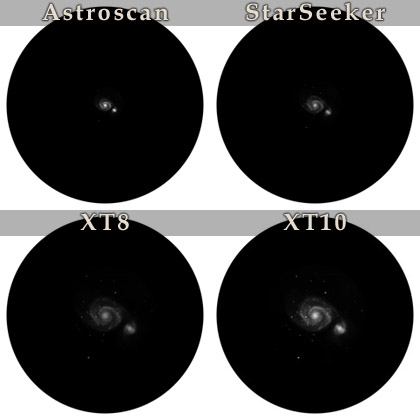
Remember that this view is simulated. I have tried to capture the relative brightness from one telescope to the other, and I have scaled M51 appropriately. But seeing something through a telescope is very different from seeing it on a computer screen.
Galaxies Compared
There are billions of galaxies out there; most are featureless specs even with the Hubble space telescope. But there are a handful of bright galaxies that are impressive even through a small scope.
Galaxies are very faint, so wait for a moonless night or until the moon has set. The light from even a sliver of the moon is enough to wash out your view. Do not even try to see a galaxy with the full moon. Make sure your eyes are dark adapted and that there are no lights nearby.
The best technique for observing galaxies is to use averted vision. Don’t stare directly at the galaxy—look away instead. The edge of your vision is much more light-sensitive than the center. Use a large eyepiece to start (25 mm or larger). As you get more familiar with what you are seeing, you can switch to a smaller eyepiece to get more magnification. And remember, use your imagination. Remember what you are looking at!
M31
The Andromeda Galaxy, our nearest major galactic neighbor, is almost too big to see. It is three times wider than the full moon, and the telescopes above will show only its nucleus. Nevertheless, it is a wonderful sight. See if you can pick out two fuzzy stars near M31—those its satellite galaxies, M32 and M110. The Andromeda Galaxy is best seen in November.
M81
This beautiful galaxy is near the Big Dipper and is one of the brightest galaxies in the sky. Admire its broad oval and see if you can see any hint of arms. Now look around the field of view and search for a cigar-shaped fuzz. That’s M82, another galaxy!
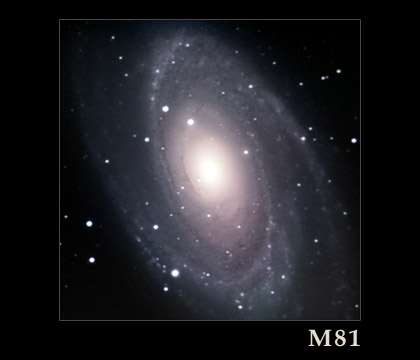
M51
The Whirlpool galaxy is one of the most iconic galaxies. It’s beautiful spiral should be visible even with small scopes, but it will take very dark skies. If you see M51, I promise you will never forget it.
